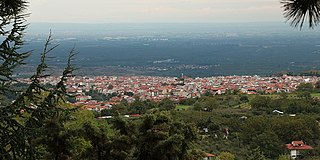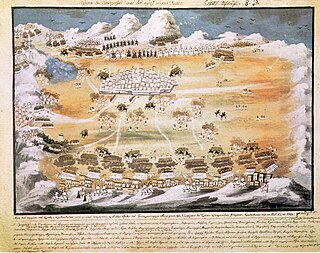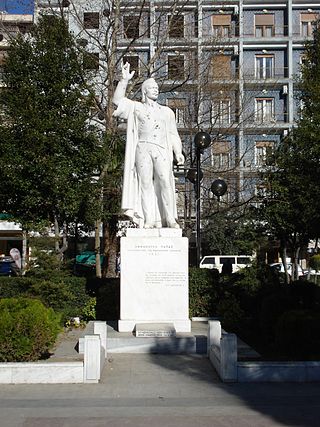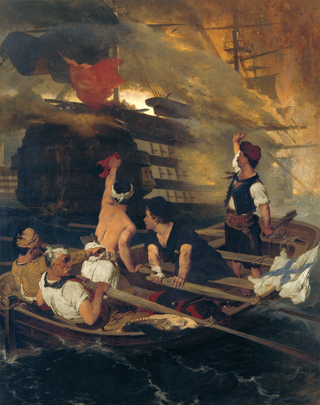
The Greek War of Independence, also known as the Greek Revolution or the Greek Revolution of 1821, was a successful war of independence by Greek revolutionaries against the Ottoman Empire between 1821 and 1829. In 1826, the Greeks were assisted by the British Empire, Kingdom of France, and the Russian Empire, while the Ottomans were aided by their North African vassals. The war led to the formation of modern Greece, which would be expanded to its modern size in later years. The revolution is celebrated by Greeks around the world as independence day on 25 March.

The Orlov revolt was a Greek uprising in the Peloponnese and later also in Crete that broke out in February 1770, following the arrival of Russian Admiral Alexey Orlov, commander of the Imperial Russian Navy during the Russo-Turkish War (1768–1774), at the Mani Peninsula. The revolt, a major precursor to the Greek War of Independence, was part of Catherine the Great's so-called "Greek Plan" and was eventually suppressed by the Ottomans.

The Adana massacre occurred in the Adana Vilayet of the Ottoman Empire in April 1909. A massacre of Armenian Christians by Ottoman Muslims in the city of Adana amidst the Ottoman countercoup of 1909 expanded to a series of anti-Armenian pogroms throughout the province. Around 20,000 to 25,000 people were killed in Adana and surrounding towns, mostly Armenians; it was reported that about 1,300 Assyrians were also killed during the massacres. Unlike the earlier Hamidian massacres, the events were not organized by the central government but instead instigated by local officials, intellectuals, and Islamic clerics, including Committee of Union and Progress (CUP) supporters in Adana. Professor of History Ronald Grigor Suny from the University of Michigan describes Adana as "more like an urban riot that degenerated into a pogrom rather than a state-initiated mass killing".

The Great Syrian Revolt, also known as the Revolt of 1925, was a general uprising across the State of Syria and Greater Lebanon during the period of 1925 to 1927. The leading rebel forces initially comprised fighters of the Jabal Druze State in southern Syria, and were later joined by Sunni, Druze and Shiite and factions all over Syria. The common goal was to end perceived French occupation in the newly mandated regions, which passed from Turkish to French administration following World War I.

Naousa, officially The Heroic City of Naousa is a city in the Imathia regional unit of Central Macedonia, Greece. It is located at the foot of the Vermio Mountains. According to the 2021 census its population was 19,706 inhabitants. The wider municipality, after the administrative reform of the Kallikratis plan, had a population of 30,054 inhabitants. Since 1955, by royal decree, it has been designated as a heroic city for the struggle and sacrifices of the inhabitants in 1822, during the Greek War of Independence.

Anastasios Karatasos was a Greek military commander during the Greek War of Independence was born in the village of Dovras, Imathia and is considered to be the most important revolutionary from Macedonia.

Sarantis-Tellos Agapinos known by the nom de guerreTellos Agras, was a Greek officer of the Hellenic Army who played a prominent role during the Greek Struggle for Macedonia.

Reşid Mehmed Pasha, also known as Kütahı, was an Ottoman statesman and general who reached the post of Grand Vizier in the first half of the 19th century, playing an important role in the Greek War of Independence.

There were numerous massacres during the Greek War of Independence (1821–1829) perpetrated by both the Ottoman forces and the Greek revolutionaries. The war was characterized by a lack of respect for civilian life, and prisoners of war on both sides of the conflict. Massacres of Greeks took place especially in Ionia, Crete, Constantinople, Macedonia and the Aegean islands. Turkish, Albanian, Greeks, and Jewish populations, who were identified with the Ottomans inhabiting the Peloponnese, suffered massacres, particularly where Greek forces were dominant. Settled Greek communities in the Aegean Sea, Crete, Central and Southern Greece were wiped out, and settled Turkish, Albanian, Greeks, and smaller Jewish communities in the Peloponnese were destroyed.

The siege of Tripolitsa or fall of Tripolitsa, also known as the Tripolitsa massacre, was an early victory of the revolutionary Greek forces in the summer of 1821 during the Greek War of Independence, which had begun earlier that year, against the Ottoman Empire. Tripolitsa was an important target, because it was the administrative center of the Ottomans in the Peloponnese.

Emmanouel Pappas was a prominent member of Filiki Eteria and leader of the Greek War of Independence in Macedonia.
The Battle of Valtetsi was fought on 24 May (N.S.), 1821 in Valtetsi between the Ottoman army and Greek revolutionaries.
The Albanian revolts of 1833–1839 took place in Albania as a reaction against the new centralizing policy of Ottoman administration.

Tafil Buzi was an Albanian leader and fighter, known for his role in various rebellions against the Ottoman government of southern Albania during the Albanian Revolts of 1833-1839. Throughout his uprisings, he maintained contacts with Muhammad Ali of Egypt and Greek politicians. As punishment for his continuous rebellions, he was captured and interned by the Ottoman government in 1840. In 1842, he was pardoned and acted as leader in service of the Ottoman government in Syria. He died there in 1844.
The Constantinople massacre of 1821 was orchestrated by the authorities of the Ottoman Empire against the Greek community of Constantinople in retaliation for the outbreak of the Greek War of Independence (1821–1830). As soon as the first news of the Greek uprising reached the Ottoman capital, there occurred mass executions, pogrom-type attacks, destruction of churches, and looting of the properties of the city's Greek population. The events culminated with the hanging of the Ecumenical Patriarch, Gregory V and the beheading of the Grand Dragoman, Konstantinos Mourouzis.
Stamatios (Stamos) Kapsas, known as Kapetan Chapsas, was a chieftain of the Greek Revolution of 1821 from Chalkidiki.

The burning of the Ottoman flagship off Chios took place on the night of 18 June 1822. The event, occurring during the Greek War of Independence, was a reprisal for the Chios massacre which occurred two months earlier. Two thousand Ottoman sailors were killed, as was Nasuhzade Ali Pasha, the Kapudan Pasha of the Ottoman Navy.
The Battle of Vasilika was fought on 10 June 1821 in Greece, between the Ottoman and the Greek forces led by the Captain Stamatios Kapsas.
AthanasiosKampitis was a Greek klepht who was active in the area of Naoussa. He fought in the revolution of Naoussa next to military commanders such as Anastasios Karatasos, Angelis Gatsos and Zafeirakis Theodosiou. He was hanged in 1822 in Veria.














